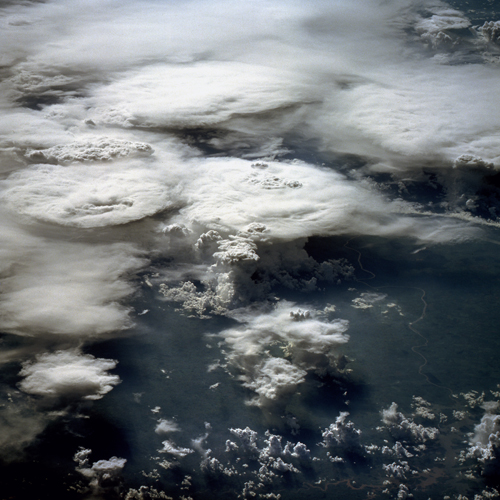How much do we know about clouds and the effects they have on climate change? It’s a lingering source of uncertainty, with as many questions as answers. No wonder the National Science Foundation calls them “The Wild Card of Climate Change” on its new website about the effect of clouds in climate.
The site is good place to start thinking about this complicated issue. The NSF page features videos of cloud experts like David Randall of Colorado State University and AMS President Peggy LeMone of NCAR, as well as a slide show, animations, articles, and other educational material that address some of most salient cloud/climate questions, such as: Will clouds help speed or slow climate change? Why is cloud behavior so difficult to predict? And how are scientists learning to project the behavior of clouds?
The impression one gets from the website about the progress of the science in this area may vary depending on your point of view, but Randall, for one, sounds about as optimistic as you can get. In his video, he admits that optimism is a job requirement for climate modelers, but in his assessment, “We’re not in the infant stages of understanding [clouds] any more; we’re in first or second grade, and on the way to adolescence.” His hope for solving their role in climate and representing cloud effects in climate modeling rests in part on better computers and in part on the numerous bright people entering the field now, ready to overshadow the work of their mentors.
The AMS Annual Meeting in Seattle will be a good occasion to dig deeper at the roots of Randall’s optimism and sample some of the emerging solutions to the cloud/climate relationship. For example, Andrei Sokolov and Erwan Monier of MIT will discuss the influence that adjusting cloud feedback has on climate sensitivity (Wednesday, 26 January, 11:30 a.m. in Climate Variability and Change). Basically, they’re using small adjustments to the cloud cover used to calculate surface radiation in a model to create a suite of results–an ensemble. The range of results better reflects the sensitivity of climate observed in the 20th century better than some other methods of creating ensembles, such as adjusting the model physics.
Randall says in his video that early predictions about climate change are already coming to pass and this leads to optimism that more predictions will verify well in the coming years as we scrutinize climate more and more closely. This of course presupposes sustained efforts to observe and verify. Laying the groundwork for this task–and for thus better climate models–are Stuart Evans (University of Washington) and colleagues in a study they are presenting in Seattle. According to their abstract, “Improving cloud parameterizations in large scale models hinges on understanding the statistical connection between large scale dynamics and the cloud fields they produce.” Their study focuses on the relationship between synoptic-scale dynamic patterns and cloud properties (Monday, 24 January, 11 a.m. in Climate Variability and Change). Evans et al. dig through 13 years of cloud vertical radar profiles from the US Southern Plains site of the DOE ARM program and relate it to atmospheric “states”, thus providing a metric for evaluating how well climate models relate cloudiness to radiation and other surface properties.
While Evans and colleagues use upward looking remote sensing, Joao Teixeira (JPL/Cal Tech) and coauthors look down at boundary layer cloudiness from above–using satellites. They expect to show how new methodologies with satellite data can improve the way low level clouds are parameterized in climate models (Thursday, 27 January, 9:30 a.m., in Climate Variability and Change). A recent workshop at Cal Tech on space-based studies of this problem stated:
Clouds in the boundary layer, the lowermost region of the atmosphere adjacent to the Earth’s surface, are known to play the key role in climate feedbacks that lead to these large uncertainties. Yet current climate models remain far from realistically representing the cloudy boundary layer, as they are limited by the inability to adequately represent the small-scale physical processes associated with turbulence, convection and clouds.
The lack of realism of the models at this low level is compounded by the lack of global observing of what goes on underneath the critical low-level cloud cover–hence the effort of Teixeira et al. (and others) to “leverage” satellite observing, with its global reach, to improve understanding of low level thermodynamics in the name of improving climate simulations.
